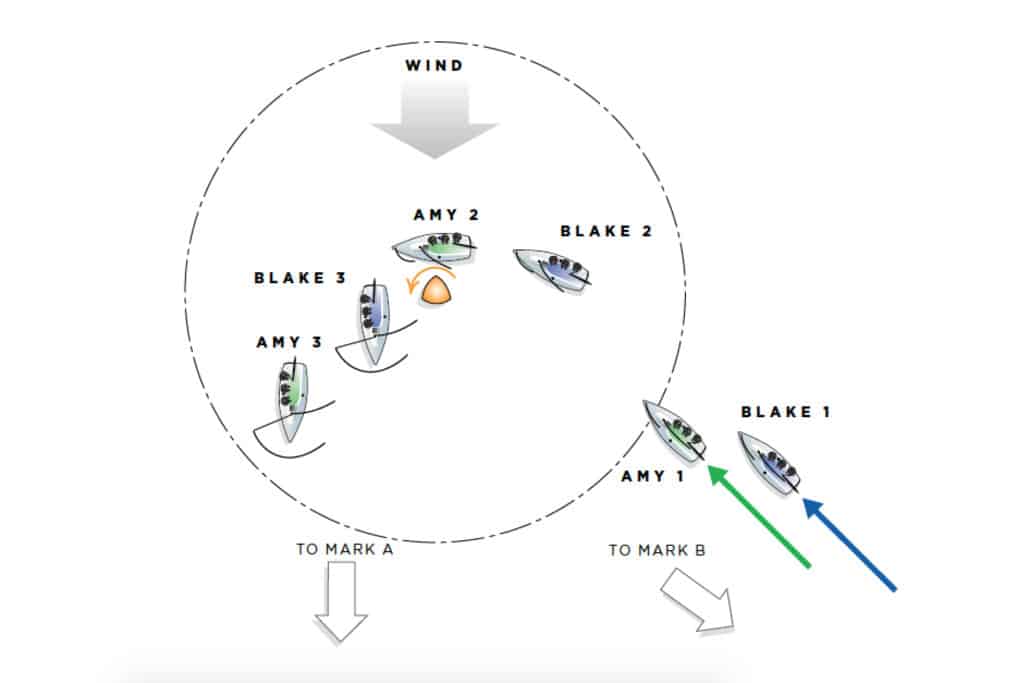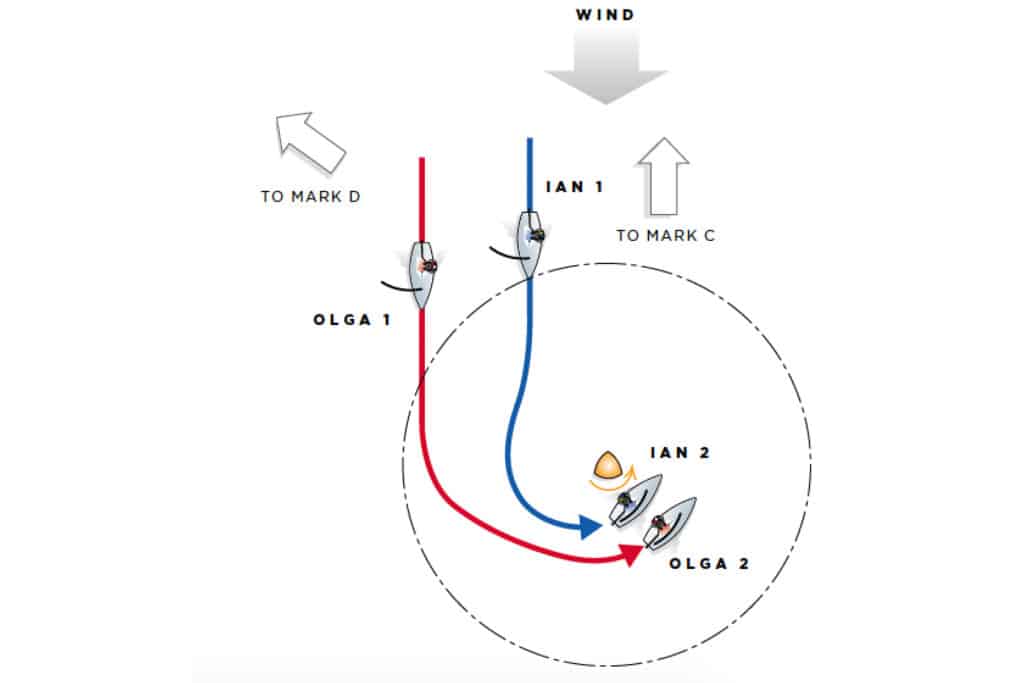
In this, the second in a series of articles covering important rule changes for 2017, we look at new wording in new Rule 18.2(d). This rule contains one important new statement, followed by two old, familiar statements that were in the last sentence of Rule 18.2(c) from 2009 through 2016.
At first reading, the new statement seems simple, even obvious. When we dig into its implications, however, you will see it requires careful study. (Note that to make room for new Rule 18.2(d), current Rules 18.2(d) and 18.2(e) will be renumbered as 18.2(e) and 18.2(f) in 2017.)
NEW RULE 18.2(d)
(d) Rules 18.2(b) and (c) cease to apply when the boat entitled to mark-room has been given that mark-room, or if she passes head to wind or leaves the zone.
When you enter a mark’s zone, if you are overlapped inside or clear ahead of another boat, that other boat must “thereafter” give you mark-room (see Rule 18.2(b)). The word “thereafter” begs the question, “When is a boat entitled to mark-room under Rule 18.2(b) or 18.2(c) no longer entitled to that mark-room?” The answer to this question, as we will see, is useful in common situations at windward or leeward marks, and is crucial to knowing whether a boat will be exonerated under Rule 21, Exoneration. Rule 18.2(d) provides the answer: A boat’s entitlement to mark-room under Rules 18.2(b) and 18.2(c) ends when she “has been given that mark-room.”
To apply the first part of new Rule 18.2(d), you need to know the definitions Mark-Room and Room, because when you’re entitled to mark-room, you’re entitled to room to make up to four maneuvers:
No. 1: Room to leave the mark on the required side.
No. 2: When your proper course is to sail close to the mark, room to sail to the mark.
No. 3: Room to round the mark as necessary to sail the course.
No. 4: Room to tack if you are overlapped inside and to windward of the boat required to give you mark-room, and if you would be fetching the mark after your tack.
A boat entitled to mark-room is always entitled to No. 1, is usually entitled to No. 2 and No. 3, and is only occasionally entitled to No. 4. To determine whether a boat has been given mark-room, you must determine which of those four maneuvers the boat was entitled to make and consider whether she has been given room for each one.
Let’s see how this works in common situations, first at a windward mark and then at a leeward mark. To apply the rule, you must consider the location of the next mark.
Look at Diagram A and assume that the wind is from the north and the next mark is Mark A, directly downwind. In Position 1, when Amy reaches the zone, she is either overlapped inside or clear ahead of Blake, so she is entitled to mark-room under either the first or the second sentence of Rule 18.2(b).
At Position 3, Amy has just borne away to a course to Mark A, the next mark. At that time Amy, who had been entitled to room for maneuvers No. 1, No. 2 and No. 3, has been given room for all three, and so, under new Rule 18.2(d), Amy’s entitlement to mark-room ceases at Position 3.
This is important because it means that Amy’s protection under Rule 21(a) also ceases at Position 3. Therefore, if Amy were to jibe onto port tack to get into stronger wind on the east side of the course, she would not be exonerated under Rule 21(a) if she broke Rule 10 by causing Blake, who is on starboard, to change course after her jibe.
Now let’s assume the next mark is not Mark A but Mark B, well east of Mark A. Jibing is a part of the rounding of the windward mark that is “necessary to sail the course” to Mark B. Because Amy must jibe to sail to Mark B, Rule 18.2(d) tells us that her entitlement to mark-room does not end until she has jibed and is on a course toward Mark B, or until she leaves the zone, whichever happens first.
If Amy jibed at Position 3, she would still enjoy the benefit of Rule 21(a). That rule would exonerate her if, while jibing onto port, she broke Rule 10 with respect to Blake.
There is one more point to make about Diagram A: If Blake had become overlapped inside Amy before Position 3, Rule 18.2(c)(2) would have applied. It states that Blake must give Amy room to sail her proper course while she and Blake remain overlapped.
One subtle point to note is that the room for Amy to sail her proper course is not one of the types of room listed in the definition Mark-Room. If the next mark is Mark A, Rule 18.2(c)(2) is of no help to Amy because at Position 3, Rule 18.2(d) switches off Rule 18.2(c)(2). So at Position 3, Amy would not be exonerated under Rule 21(a) if she jibed and, in so doing, broke Rule 10. If the next mark is Mark B, Rule 18.2(c)(2) is once again of no help to Amy because, as noted above, she is already protected by Rule 21(a) when she jibes, because her jibe is necessary to sail the course to Mark B. (Rule 18.2(c)(2) does sometimes play an important role, but not in these situations at the windward mark.

The situation in Diagram B gives new Rule 18.2(d) a workout at a leeward mark. Ian and Olga are running on port tack. The wind is from the north. Ian is the first of the pair to reach the zone around the leeward mark, and at that moment, he is overlapped inside Olga. We begin by assuming the next mark is Mark C, directly to windward of the mark the boats are rounding. Rule 18.2(b) entitles Ian to room for maneuvers No. 1, No. 2 and No. 3. At Position 2, Olga has given Ian room to sail to the mark (No. 2) and room to round up to closehauled, which is the rounding “necessary to sail the course” (No. 3). What about No. 1, room for Ian to leave the mark on the required side, which is room to pass the mark on his port side?
At Position 2, Ian has not quite passed the mark, and Olga is so close to Ian that she could still luff him as high as head to wind before he was past the mark. This would deny Ian space to pass the mark in a seamanlike way. Therefore, at Position 2, Ian has not quite been given room for No. 1. That room will have been given a couple of seconds later, when the mark is astern of Ian.
Now let’s assume the next mark is not Mark C but Mark D, well west of Mark C. Tacking is a part of the rounding of the leeward mark that is “necessary to sail the course” to Mark D. Ian is overlapped inside and to windward of Olga, and Ian would be fetching the leeward mark if he tacked at or shortly after Position 2.
Therefore, in this case, Ian is also entitled to room to tack (No. 4).
Under Rule 18.2(d), Ian’s entitlement to mark-room will end when he “passes head to wind,” which he will do halfway through his tack. Until that time, Olga must give him room to tack. If the starboard corner of Ian’s transom hit Olga’s port topside just after he passed head to wind, Olga would have broken Rule 18.2(b) because the contact would be clear evidence that Olga had not given Ian room to tack in the moments just before he passed head to wind. When the next mark is Mark D and tacking is a necessary part of the rounding to sail the course, Ian remains entitled to mark-room until he passes head to wind.
This is a good time to repeat a disclaimer that I include in these articles every couple of years. Rule 18.2(d) is new and has not yet been interpreted by World Sailing in its Case Book or by US Sailing in its Appeals Book. The interpretations I make here are my own interpretations and not in any way official.
Email for Dick Rose may be sent to rules@sailingworld.com.









